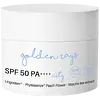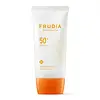What's inside
What's inside
 Key Ingredients
Key Ingredients

 Benefits
Benefits

 Concerns
Concerns

 Ingredients Side-by-side
Ingredients Side-by-side

Water
Skin ConditioningGlycerin
HumectantDiethylamino Hydroxybenzoyl Hexyl Benzoate
UV FilterBis-Ethylhexyloxyphenol Methoxyphenyl Triazine
Skin ConditioningEthylhexyl Triazone
UV AbsorberCetyl Alcohol
EmollientCetearyl Alcohol
EmollientGlyceryl Stearate
EmollientMethylene Bis-Benzotriazolyl Tetramethylbutylphenol
UV FilterCoco-Caprylate/Caprate
EmollientIsopropyl Myristate
EmollientPropylheptyl Caprylate
EmollientHydrogenated Farnesene
EmollientOlea Europaea Fruit Oil
MaskingStearic Acid
CleansingPassiflora Incarnata Seed Oil
Skin ProtectingPrunus Persica Flower Extract
MoisturisingCamellia Sinensis Leaf Extract
AntimicrobialVaccinium Vitis-Idaea Fruit Extract
AntioxidantLinum Usitatissimum Seed Extract
PerfumingAlthaea Officinalis Root Extract
Skin ConditioningPrunus Amygdalus Dulcis Fruit Extract
Skin ConditioningHydrolyzed Glycosaminoglycans
HumectantSodium Hyaluronate
HumectantHyaluronic Acid
HumectantHydrolyzed Hyaluronic Acid
HumectantSodium Hyaluronate Crosspolymer
HumectantTocopherol
AntioxidantGlycine Soja Oil
EmollientSodium Lauroyl Glutamate
Hydroxypropyl Starch Phosphate
Decyl Glucoside
CleansingZea Mays Starch
AbsorbentPropanediol
SolventGluconolactone
Skin ConditioningTocopheryl Acetate
AntioxidantCalcium Gluconate
HumectantDehydroacetic Acid
PreservativeXanthan Gum
EmulsifyingPropylene Glycol
HumectantCitric Acid
BufferingParfum
MaskingRaspberry Ketone
MaskingPotassium Sorbate
PreservativeSodium Benzoate
MaskingBenzyl Glycol
SolventPhenoxyethanol
PreservativeEthylhexylglycerin
Skin ConditioningBenzyl Alcohol
PerfumingCitral
PerfumingLinalool
PerfumingWater, Glycerin, Diethylamino Hydroxybenzoyl Hexyl Benzoate, Bis-Ethylhexyloxyphenol Methoxyphenyl Triazine, Ethylhexyl Triazone, Cetyl Alcohol, Cetearyl Alcohol, Glyceryl Stearate, Methylene Bis-Benzotriazolyl Tetramethylbutylphenol, Coco-Caprylate/Caprate, Isopropyl Myristate, Propylheptyl Caprylate, Hydrogenated Farnesene, Olea Europaea Fruit Oil, Stearic Acid, Passiflora Incarnata Seed Oil, Prunus Persica Flower Extract, Camellia Sinensis Leaf Extract, Vaccinium Vitis-Idaea Fruit Extract, Linum Usitatissimum Seed Extract, Althaea Officinalis Root Extract, Prunus Amygdalus Dulcis Fruit Extract, Hydrolyzed Glycosaminoglycans, Sodium Hyaluronate, Hyaluronic Acid, Hydrolyzed Hyaluronic Acid, Sodium Hyaluronate Crosspolymer, Tocopherol, Glycine Soja Oil, Sodium Lauroyl Glutamate, Hydroxypropyl Starch Phosphate, Decyl Glucoside, Zea Mays Starch, Propanediol, Gluconolactone, Tocopheryl Acetate, Calcium Gluconate, Dehydroacetic Acid, Xanthan Gum, Propylene Glycol, Citric Acid, Parfum, Raspberry Ketone, Potassium Sorbate, Sodium Benzoate, Benzyl Glycol, Phenoxyethanol, Ethylhexylglycerin, Benzyl Alcohol, Citral, Linalool
Water
Skin ConditioningEthylhexyl Methoxycinnamate
UV AbsorberTitanium Dioxide
Cosmetic ColorantGlycerin
HumectantDipropylene Glycol
HumectantDibutyl Adipate
EmollientC12-15 Alkyl Benzoate
AntimicrobialDiethylamino Hydroxybenzoyl Hexyl Benzoate
UV FilterNiacinamide
SmoothingEthylhexyl Triazone
UV AbsorberGlyceryl Stearate
EmollientCetearyl Alcohol
EmollientCetyl Alcohol
EmollientPolysorbate 60
EmulsifyingDimethicone
EmollientPEG-100 Stearate
Aluminum Hydroxide
EmollientCetearyl Olivate
Glyceryl Caprylate
EmollientSorbitan Olivate
EmulsifyingPolyhydroxystearic Acid
EmulsifyingHydroxyethyl Acrylate/Sodium Acryloyldimethyl Taurate Copolymer
Emulsion StabilisingStearyl Alcohol
EmollientCetearyl Glucoside
EmulsifyingMethicone
EmollientTocopheryl Acetate
AntioxidantMyristyl Alcohol
EmollientAdenosine
Skin ConditioningLauryl Alcohol
EmollientSorbitan Isostearate
EmulsifyingPearl Powder
Citrus Unshiu Peel Extract
MaskingCoco-Caprylate/Caprate
EmollientButylene Glycol
HumectantGlucose
HumectantMacadamia Ternifolia Seed Oil
EmollientVitis Vinifera Seed Oil
EmollientPrunus Armeniaca Kernel Oil
MaskingPropylene Glycol
HumectantPEG-5 Rapeseed Sterol
CleansingCholesterol
EmollientBrassica Campestris Sterols
EmollientBiosaccharide Gum-4
Skin ConditioningMangifera Indica Fruit Extract
Skin ConditioningHydrogenated Lecithin
EmulsifyingGlutathione
Garcinia Mangostana Peel Extract
Skin ConditioningCeteth-5
EmulsifyingCeteth-3
EmulsifyingSolanum Lycopersicum Seed Oil
EmollientSodium Ascorbyl Phosphate
AntioxidantPunica Granatum Seed Oil
EmollientMangifera Indica Seed Oil
EmollientCitrus Paradisi Seed Oil
PerfumingCetyl Phosphate
EmulsifyingEthylhexylglycerin
Skin ConditioningMalpighia Emarginata Fruit Extract
Skin ConditioningTocopherol
AntioxidantPhenoxyethanol
Preservative1,2-Hexanediol
Skin ConditioningChlorphenesin
AntimicrobialDisodium EDTA
Parfum
MaskingCoumarin
PerfumingAlpha-Isomethyl Ionone
PerfumingCitronellol
PerfumingHydroxycitronellal
PerfumingWater, Ethylhexyl Methoxycinnamate, Titanium Dioxide, Glycerin, Dipropylene Glycol, Dibutyl Adipate, C12-15 Alkyl Benzoate, Diethylamino Hydroxybenzoyl Hexyl Benzoate, Niacinamide, Ethylhexyl Triazone, Glyceryl Stearate, Cetearyl Alcohol, Cetyl Alcohol, Polysorbate 60, Dimethicone, PEG-100 Stearate, Aluminum Hydroxide, Cetearyl Olivate, Glyceryl Caprylate, Sorbitan Olivate, Polyhydroxystearic Acid, Hydroxyethyl Acrylate/Sodium Acryloyldimethyl Taurate Copolymer, Stearyl Alcohol, Cetearyl Glucoside, Methicone, Tocopheryl Acetate, Myristyl Alcohol, Adenosine, Lauryl Alcohol, Sorbitan Isostearate, Pearl Powder, Citrus Unshiu Peel Extract, Coco-Caprylate/Caprate, Butylene Glycol, Glucose, Macadamia Ternifolia Seed Oil, Vitis Vinifera Seed Oil, Prunus Armeniaca Kernel Oil, Propylene Glycol, PEG-5 Rapeseed Sterol, Cholesterol, Brassica Campestris Sterols, Biosaccharide Gum-4, Mangifera Indica Fruit Extract, Hydrogenated Lecithin, Glutathione, Garcinia Mangostana Peel Extract, Ceteth-5, Ceteth-3, Solanum Lycopersicum Seed Oil, Sodium Ascorbyl Phosphate, Punica Granatum Seed Oil, Mangifera Indica Seed Oil, Citrus Paradisi Seed Oil, Cetyl Phosphate, Ethylhexylglycerin, Malpighia Emarginata Fruit Extract, Tocopherol, Phenoxyethanol, 1,2-Hexanediol, Chlorphenesin, Disodium EDTA, Parfum, Coumarin, Alpha-Isomethyl Ionone, Citronellol, Hydroxycitronellal
 Reviews
Reviews

Ingredients Explained
These ingredients are found in both products.
Ingredients higher up in an ingredient list are typically present in a larger amount.
Cetearyl alcohol is a mixture of two fatty alcohols: cetyl alcohol and stearyl alcohol. It is mainly used as an emulsifier. Emulsifiers help prevent the separation of oils and products. Due to its composition, it can also be used to thicken a product or help create foam.
Cetearyl alcohol is an emollient. Emollients help soothe and hydrate the skin by trapping moisture.
Studies show Cetearyl alcohol is non-toxic and non-irritating. The FDA allows products labeled "alcohol-free" to have fatty alcohols.
This ingredient is usually derived from plant oils such as palm, vegetable, or coconut oils. There is debate on whether this ingredient will cause acne.
Due to the fatty acid base, this ingredient may not be Malassezia folliculitis safe.
Learn more about Cetearyl AlcoholCetyl Alcohol is a fatty alcohol. Fatty Alcohols are most often used as an emollient or to thicken a product.
Its main roles are:
Though it has "alcohol" in the name, it is not related to denatured alcohol or ethyl alcohol.
The FDA allows products labeled "alcohol-free" to have fatty alcohols.
Learn more about Cetyl AlcoholCoco-Caprylate/Caprate is created from fatty coconut alcohol, caprylic acid, and capric acid.
It is a lightweight emollient. Emollients create a thin barrier on the skin to trap moisture in. This helps keep your skin hydrated and soft.
Once applied, Coco-Caprylate/Caprate is absorbed quickly and leaves a silky feel.
Coco-Caprylate/Caprate may not be fungal acne safe.
Learn more about Coco-Caprylate/CaprateDiethylamino Hydroxybenzoyl Hexyl Benzoate (DHHB) is a chemical UV-A absorber. It is formulated for high UVA protection (320-400 nm).
DHHB is well-liked for:
DHHB has been approved by the EU, Japan, Taiwan, and South America for use up to 10%. Unfortunately, it has not been approved for use in the US or Canada due to slow regulatory processes.
This ingredient is soluble in oils, fats, and lipids.
Learn more about Diethylamino Hydroxybenzoyl Hexyl BenzoateEthylhexyl Triazone is a modern chemical sunscreen that protects from UV-B radiation.
It is the most effective of existing UV-B filters, as it provides the highest level of photo-stable absorption. It protects from the entire UV-B range (280 to 320nm), with it's highest level of protection at 314nm.
Ethylhexyl Triazone is oil soluble, oderless and colorless, which mean it is able to be incorporated into a variety of different formulations.
It is not currently available within the United States due to slow changing FDA regulations. Outside of the US, it is used in formulations at concentrations up to 5%.
Learn more about Ethylhexyl TriazoneEthylhexylglycerin (we can't pronounce this either) is commonly used as a preservative and skin softener. It is derived from glyceryl.
You might see Ethylhexylglycerin often paired with other preservatives such as phenoxyethanol. Ethylhexylglycerin has been found to increase the effectiveness of these other preservatives.
Glycerin is already naturally found in your skin. It helps moisturize and protect your skin.
A study from 2016 found glycerin to be more effective as a humectant than AHAs and hyaluronic acid.
As a humectant, it helps the skin stay hydrated by pulling moisture to your skin. The low molecular weight of glycerin allows it to pull moisture into the deeper layers of your skin.
Hydrated skin improves your skin barrier; Your skin barrier helps protect against irritants and bacteria.
Glycerin has also been found to have antimicrobial and antiviral properties. Due to these properties, glycerin is often used in wound and burn treatments.
In cosmetics, glycerin is usually derived from plants such as soybean or palm. However, it can also be sourced from animals, such as tallow or animal fat.
This ingredient is organic, colorless, odorless, and non-toxic.
Glycerin is the name for this ingredient in American English. British English uses Glycerol/Glycerine.
Learn more about GlycerinGlyceryl Stearate is a mix of glycerin and stearic acid.
It is used to stabilize the mixing of water and oil ingredients. By preventing these ingredients from separating, it can help elongate shelf life. It can also help thicken the product's texture.
As an emollient, it helps soften skin and supports barrier-replenishing ingredients.
In cosmetics, Glyceryl Stearate is often made from vegetable oils or synthetically produced.
This ingredient may not be fungal-acne safe
Fun fact: The human body also creates Glyceryl Stearate naturally.
Learn more about Glyceryl StearateParfum is a catch-all term for an ingredient or more that is used to give a scent to products.
Also called "fragrance", this ingredient can be a blend of hundreds of chemicals or plant oils. This means every product with "fragrance" or "parfum" in the ingredients list is a different mixture.
For instance, Habanolide is a proprietary trade name for a specific aroma chemical. When used as a fragrance ingredient in cosmetics, most aroma chemicals fall under the broad labeling category of “FRAGRANCE” or “PARFUM” according to EU and US regulations.
The term 'parfum' or 'fragrance' is not regulated in many countries. In many cases, it is up to the brand to define this term.
For instance, many brands choose to label themselves as "fragrance-free" because they are not using synthetic fragrances. However, their products may still contain ingredients such as essential oils that are considered a fragrance by INCI standards.
One example is Calendula flower extract. Calendula is an essential oil that still imparts a scent or 'fragrance'.
Depending on the blend, the ingredients in the mixture can cause allergies and sensitivities on the skin. Some ingredients that are known EU allergens include linalool and citronellol.
Parfum can also be used to mask or cover an unpleasant scent.
The bottom line is: not all fragrances/parfum/ingredients are created equally. If you are worried about fragrances, we recommend taking a closer look at an ingredient. And of course, we always recommend speaking with a professional.
Learn more about ParfumPhenoxyethanol is a preservative that has germicide, antimicrobial, and aromatic properties. Studies show that phenoxyethanol can prevent microbial growth. By itself, it has a scent that is similar to that of a rose.
It's often used in formulations along with Caprylyl Glycol to preserve the shelf life of products.
Propylene Glycol is an odorless, colorless liquid. As a humectant, it helps skin retain moisture. It also aids in delivering active ingredients.
Another role of this ingredient is preventing a product from melting or freezing. Propylene glycol also adds antimicrobrial properties to a product, elongating product lifespan.
This ingredient is considered an organic alcohol and commonly added into both cosmetics and foods.
Those with sensitive skin or conditions may develop a rash when using this ingredient.
Learn more about Propylene GlycolTocopherol (also known as Vitamin E) is a common antioxidant used to help protect the skin from free-radicals and strengthen the skin barrier. It's also fat soluble - this means our skin is great at absorbing it.
Vitamin E also helps keep your natural skin lipids healthy. Your lipid skin barrier naturally consists of lipids, ceramides, and fatty acids. Vitamin E offers extra protection for your skin’s lipid barrier, keeping your skin healthy and nourished.
Another benefit is a bit of UV protection. Vitamin E helps reduce the damage caused by UVB rays. (It should not replace your sunscreen). Combining it with Vitamin C can decrease sunburned cells and hyperpigmentation after UV exposure.
You might have noticed Vitamin E + C often paired together. This is because it is great at stabilizing Vitamin C. Using the two together helps increase the effectiveness of both ingredients.
There are often claims that Vitamin E can reduce/prevent scarring, but these claims haven't been confirmed by scientific research.
Learn more about TocopherolTocopheryl Acetate is AKA Vitamin E. It is an antioxidant and protects your skin from free radicals. Free radicals damage the skin by breaking down collagen.
One study found using Tocopheryl Acetate with Vitamin C decreased the number of sunburned cells.
Tocopheryl Acetate is commonly found in both skincare and dietary supplements.
Learn more about Tocopheryl AcetateWater. It's the most common cosmetic ingredient of all. You'll usually see it at the top of ingredient lists, meaning that it makes up the largest part of the product.
So why is it so popular? Water most often acts as a solvent - this means that it helps dissolve other ingredients into the formulation.
You'll also recognize water as that liquid we all need to stay alive. If you see this, drink a glass of water. Stay hydrated!
Learn more about Water